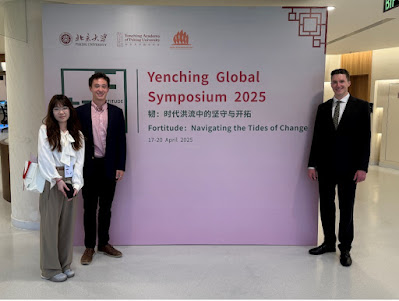Resolving International Business Disputes in Vienna
The HNC commercial arbitration team recently got back from Vienna—the
“city of music,” known for its baroque palaces and gardens—where we
competed in the Willem C. Vis International Moot. The “Vis Moot” is
often referred to as the Olympics of commercial arbitration; it attracts
nearly 400 of the world’s best law schools annually. This was the first
time HNC sent and funded its own team, which was composed of both
Chinese and American students.
Moot competitions are basically an intellectual battlefield. Each
opposing team comes armed with a bevy of legal arguments,
counterarguments, facts, cases, and interpretations of laws—in order to
attack the other team’s positions, as well as to defend their own
clients’ positions. While there are many different types of moot
competitions—such as Jessup’s international law moot and the Red Cross’s
international humanitarian law moot—the Vis Moot focuses solely on
international commercial arbitration law.
Commercial arbitration is a way to resolve business disputes between two
or more companies from different countries. Because every nation-state
has different commercial laws, it can often be tricky to do business
across borders. To address these issues, the United Nations
(specifically UNCITRAL) created uniform treaty frameworks—such as the
CISG, the New York Convention, and the Model Law—for commercial agents
to abide to. If the companies’ host countries had ratified such
treaties, the companies could use the treaties’ mechanisms to initiate
arbitration (a process of dispute resolution to figure out who gets how
much money). During this process, each company’s advocates (or
arbitration lawyers) present their arguments to arbitrators (basically
judges), who then decide on final awards.
The Vis Moot itself was a seven day ordeal, starting with the welcoming party, which turned into a dance party, organized by the Moot Alumni Association. There, we made friends with a variety of people that we would see throughout the week—memorably four girls from Belgium who did great impressions of Americans; two U.S. army veterans now studying law in Kentucky; a Russian guy who hid the fact that he spoke perfect Mandarin until seven days later; and a couple of jokesters from India who ended up winning second place overall. The next day was the official opening ceremony, held at a historic concert hall, followed by a wine reception. And finally, the third day was when competitions began.
HNC competed in four events that week, with schools from Turkey, Ireland, Georgia (the country), and Australia. These competitions took place in famous international law firms, such as Baker McKenzie and DORDA, as well as in the University of Vienna’s law school. Our competitions were judged by top international arbitrators and lawyers, including those from White & Case, The Hague’s Permanent Court of Arbitration (PCA), and the International Chamber of Commerce (ICC).
Every day was a time crunch, but also very rewarding. Our mornings (which started at 6AM, thanks to jetlag) were spent digging through legal research in the city’s gorgeous cafes (the same cafes frequented by Sigmund Freud and Leon Trotsky). Around lunchtime we would rehearse oral arguments in our hotel lounge with HNC’s professor of commercial law Feng Chuan (who also participated in Vis Moot in Vienna as a student in the early 2000s). In the afternoon, we would compete at formal events around the city. Following that, we would squeeze in some time to visit museums or historical sites along the banks of the Danube River; and finally, in the evening, we would unwind at social gatherings with fellow Mooters.
It was clear that the dynamic at Vis Moot was “work hard, play hard.”
While all the Mooters there were naturally studious (it can often be
difficult to pry these types away from the library), the Vis Moot and
alumni organizers incorporated a lot of social events into the
agenda—from historic tours of Vindobona, to dinners featuring local
cuisine (if you go, try the palatschinken), and to presentations at the
United Nations. The organizers’ goals were not only to teach students
about trade law by having them write legal memorandums and present oral
arguments in front of arbitrators, but also to encourage students to
meet people from different legal cultures and backgrounds.
To confess, most of us on the team knew very little about international law (let alone commercial arbitration) before arriving at the HNC. But all of us took relevant classes here with Professor Thomas Simon (who is also our coach), Professor Roda Mushkat, and Professor Feng Chuan. Our journey actually started eight months ago, back in September 2016, when we first met and took a leap of faith to commit to this activity and to each other. Back then, we were not fully aware of how many hours we would pour into this endeavor. We spent a lot of time searching through legal databases in the library, studying international treaties late at night, engaging in legal debates on trains and airplanes, and rehearsing our presentations with different professors and lawyers across Nanjing. All these experiences challenged us and helped us grow in a variety of ways. (For example, most of us struggled with public speaking at the beginning of the year, and now we do it with ease.)
Our first foray into organized competition was actually at the CIETAC
pre-moot in Beijing, during which we faced off against top law schools
in China. This experience really helped settle our nerves—it was the
first time any of us fielded sharp and pointed inquisitions by
professional arbitrators—and it gave us the confidence that we could
compete at the highest levels. While the competitions and debates could
get pretty heated, the spirit was always of one of collaboration,
dispute resolution, and mutual growth. In Vienna, five months after
CIETAC, we ran into some of our fiercest competitors from Beijing, and
we ended up becoming close friends.
There was not much of a “closing note” during the final ceremony—no sad coda, or anything like that. Plus, we didn’t take home the gold or score the highest this year. Rather, the final ceremony was more like the start of another movement. International trade law is a small community, and we had faith we would see each other again in our professional lives. Perhaps our biggest takeaway is that hard, faithful, and passionate work may not always yield shiny medals, but it will always produce stuff of greater meaning and deeper fulfillment. Indeed, that’s an argument we’d make any day of the week.
By George Gao, Rick Hogoboom, Benjamén DoVale, Arthur Xiaoyu Jin









